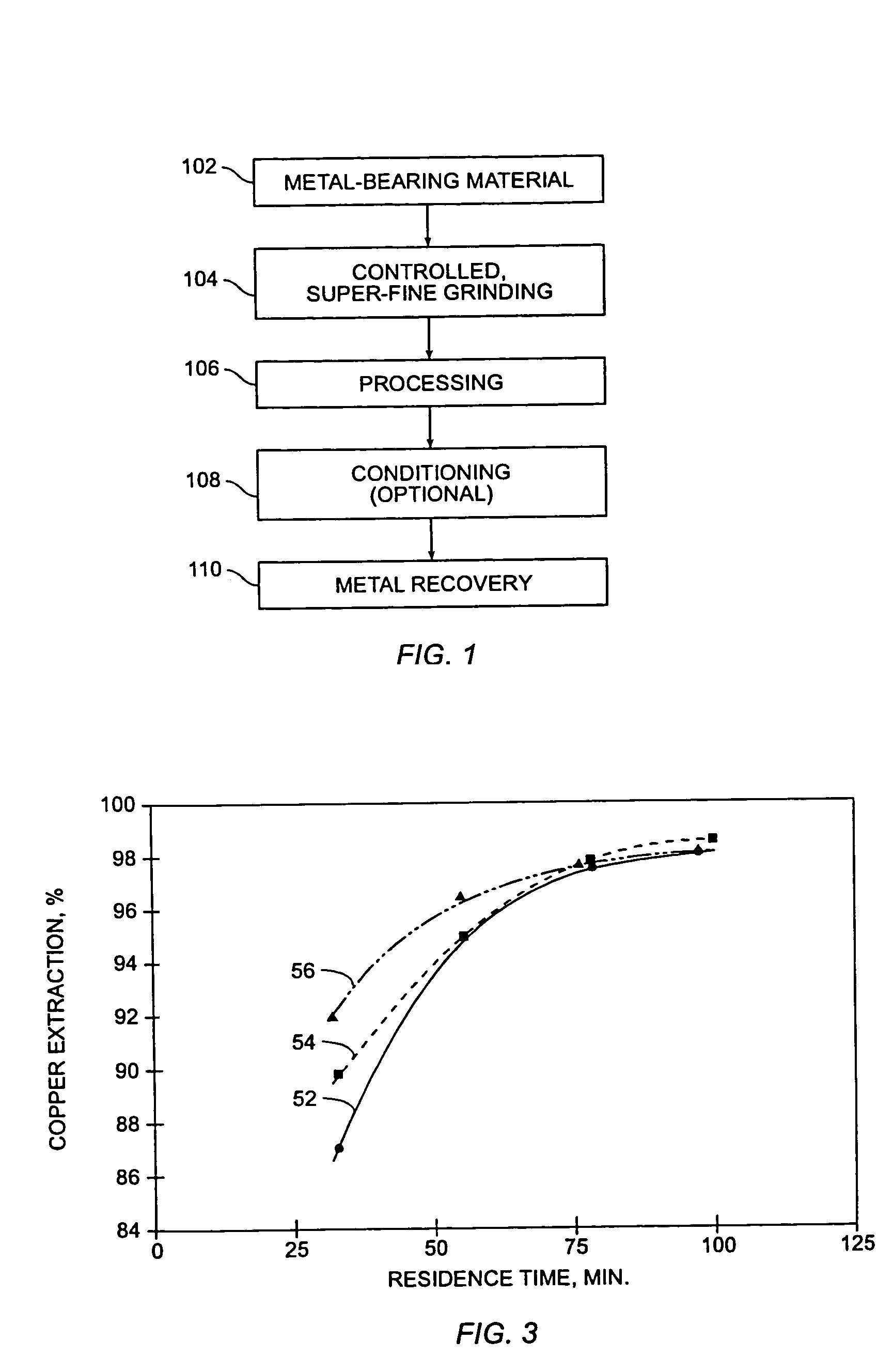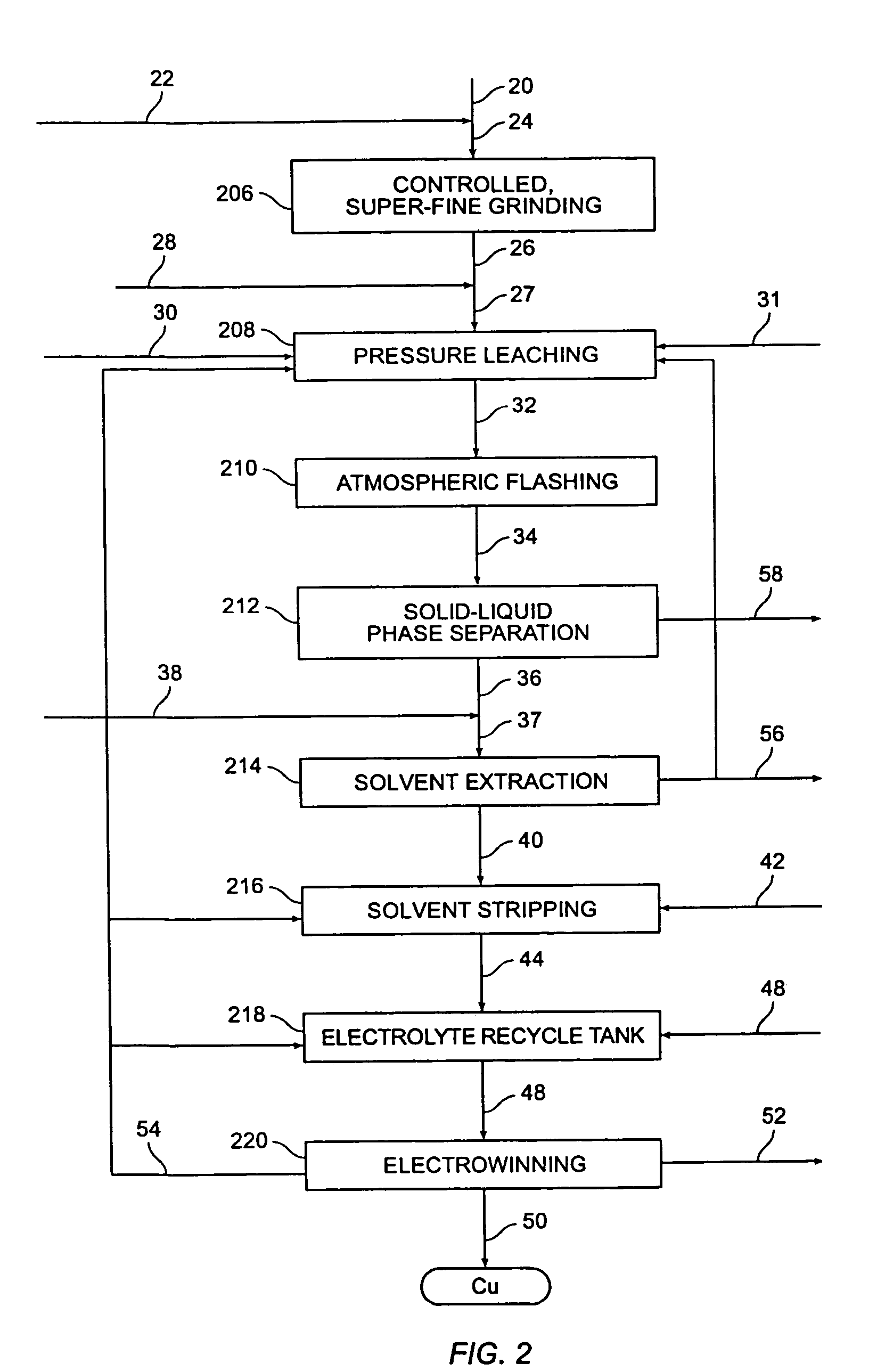Method for recovery of metals from metal-containing materials using medium temperature pressure leaching
a metal recovery and metal value technology, applied in the direction of drug compositions, group 4/14 element organic compounds, dissolving, etc., can solve the problems of high smelting cost, process disadvantages, and higher oxygen consumption, so as to enhance the recovery of copper and/or other desired metal values and enhance the recovery effect of metal valu
- Summary
- Abstract
- Description
- Claims
- Application Information
AI Technical Summary
Benefits of technology
Problems solved by technology
Method used
Image
Examples
example 1
[0059]As discussed in detail hereinabove, controlled, super-fine grinding of chalcopyrite concentrates is preferred prior to medium temperature pressure leaching at about 140° C. to about 180° C. to prevent encapsulation of unreacted copper minerals by elemental sulfur and / or copper polysulfide. The various grinding systems set forth below were used to produce an ultra-finely ground inlet stream of chalcopyrite concentrate samples containing approximately 30.5 percent copper for a medium temperature pressure leaching pilot plant. The as-received particle size of the chalcopyrite concentrate sample used in the continuous pilot plant tests was P98=approximately 101 microns. The as-received particle size of the chalcopyrite concentrate sample used in the batch tests was P98=approximately 172 microns.
[0060]1) Conventional regrind mill followed by a short grind in a Union Process stirred pin mill—material was reground in a conventional regrind mill for sixty (60) minutes followed by five...
example 2
[0068]Batch results also indicate that copper extraction is sensitive to grind fineness. The batch tests were performed to confirm that the products of Netzsch mill processing would react similarly to the products of Metprotech processing. The grinding systems indicated in Table 2 correspond to the grinding systems identified in Example 1.
[0069]
TABLE 2Copper Extraction versus Grind Fineness in Batch TestsGrindingSize in Microns% CuResidueSystemP80P90P95P98Extractedwt % Cu160° C., 500 kg / tonne H2SO459.813.818.927.897.70.95459.913.618.628.198.40.66445.79.413.921.399.20.32766.27.89.212.199.20.358170° C., 500 kg / tonne H2SO459.813.818.927.895.11.93066.27.89.212.199.20.343
example 3
[0070]FIG. 3 is a graphical profile of continuous pilot plant test data illustrating copper extraction as a function of time in accordance with various embodiments of the present invention. For each test run, the chalcopyrite concentrate samples were ground to a P98 of less than about 23 microns. Calcium lignosulfonate from Georgia Pacific Corp. was introduced to the pressure leaching vessels in an amount of about 10 kilograms per tonne of concentrate.
[0071]Curve 52 illustrates copper extraction versus residence time for medium temperature pressure leaching of chalcopyrite at approximately 160° C., with acid addition to the pressure leaching vessel of about 580 kilograms per tonne. Approximately 96% copper extraction was achieved at about 60 minutes, and 98+% copper extraction was achieved at a residence time of about 95 minutes.
[0072]Curve 54 illustrates copper extraction versus residence time for medium temperature pressure leaching of chalcopyrite at approximately 170° C., with a...
PUM
| Property | Measurement | Unit |
|---|---|---|
| Temperature | aaaaa | aaaaa |
| Temperature | aaaaa | aaaaa |
| Temperature | aaaaa | aaaaa |
Abstract
Description
Claims
Application Information
 Login to View More
Login to View More - R&D
- Intellectual Property
- Life Sciences
- Materials
- Tech Scout
- Unparalleled Data Quality
- Higher Quality Content
- 60% Fewer Hallucinations
Browse by: Latest US Patents, China's latest patents, Technical Efficacy Thesaurus, Application Domain, Technology Topic, Popular Technical Reports.
© 2025 PatSnap. All rights reserved.Legal|Privacy policy|Modern Slavery Act Transparency Statement|Sitemap|About US| Contact US: help@patsnap.com


